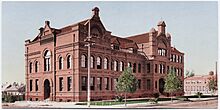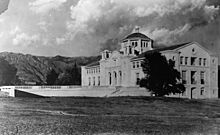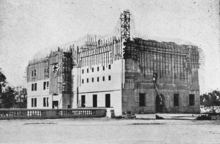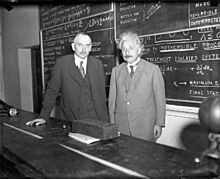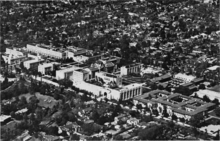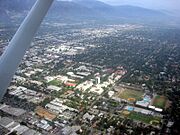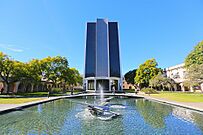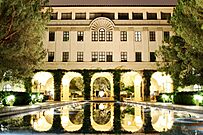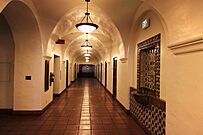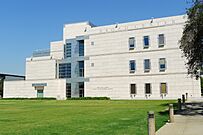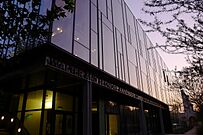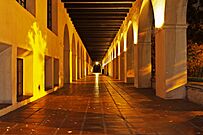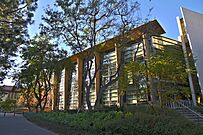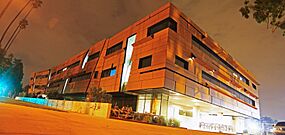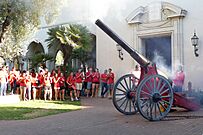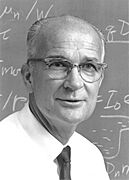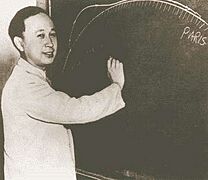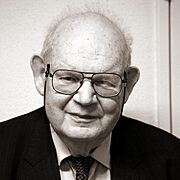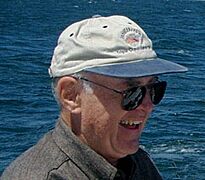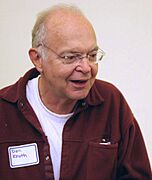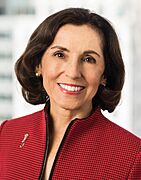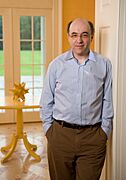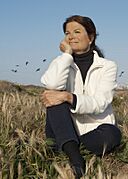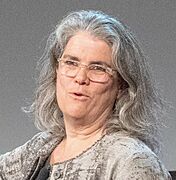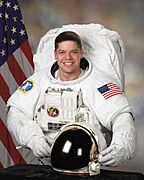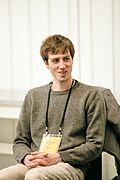California Institute of Technology facts for kids
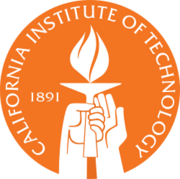 |
|
|
Former names
|
List
|
|---|---|
| Motto | "The truth shall make you free" |
| Type | Private research university |
| Established | September 23, 1891 |
| Founder | Amos G. Throop |
| Accreditation | WSCUC |
|
Academic affiliations
|
|
| Endowment | $4.7 billion (2025) |
| President | Thomas F. Rosenbaum |
| Provost | David. A. Tirrell |
|
Academic staff
|
300 professorial faculty |
| Students | 2,430 (2024–25) |
| Undergraduates | 987 (2024-25) |
| Postgraduates | 1,443 (2024-25) |
| Location |
,
California
,
United States
34°08′15″N 118°07′30″W / 34.13750°N 118.12500°W |
| Campus | Midsize city, 124 acres (0.50 km2) |
| Newspaper | The California Tech |
| Nickname | Beavers |
|
Sporting affiliations
|
NCAA Division III – SCIAC |
| Mascot | Bernoulli the Beaver |
The California Institute of Technology (often called Caltech) is a special private university in Pasadena, California, USA. It's known for its amazing work in science and engineering. Caltech is one of the few schools in the United States that focuses mainly on teaching pure and applied sciences.
The school started in 1891 as a vocational school by Amos G. Throop. In the early 1900s, famous scientists like George Ellery Hale and Robert Andrews Millikan joined. The school changed its name to Caltech in 1920. Caltech manages NASA's Jet Propulsion Laboratory (JPL), which was started between 1936 and 1943.
Caltech has six main areas of study, all focused on science and engineering. Its main campus is about 11 miles (18 km) northeast of downtown Los Angeles. First-year students must live on campus, and most undergraduates stay in the campus housing system. Students follow an honor code, which means they can take tests home. The Caltech Beavers sports teams compete in 13 different sports.
Scientists and engineers from Caltech have made huge discoveries in space research, sustainability science, quantum physics, and seismology. As of October 2024, 80 Nobel Prize winners have been connected to Caltech. This includes 47 former students and teachers. Caltech has the highest number of Nobel winners per person in America. Many other award winners, astronauts, and important leaders have also been part of Caltech.
Contents
Caltech's Story
Early Days as Throop College
Caltech began as a school for practical skills on September 23, 1891. It was founded by a local businessman named Amos G. Throop. The school had different names before it became Caltech in 1920. In 1907, the part of the school that taught practical skills was separated to form the Polytechnic School.
At that time, scientific research in the U.S. was just starting. George Ellery Hale, a solar astronomer, joined Throop's board in 1907. He helped turn the school into a major science center. He brought in James Augustin Brown Scherer as president in 1908, who was good at raising money. Scherer convinced a businessman to donate money for Gates Laboratory, the first science building.
During the World Wars
In 1910, Throop moved to its current location. Theodore Roosevelt gave a speech there in 1911. He said he wanted schools like Throop to train people to do industrial work very well. He also wanted them to train a few people to become great scientists.
During World War I, Hale helped create the United States National Research Council. This group supported scientific work for military needs. Hale also worked to get more money for science from private sources. This led to the creation of the Norman Bridge Laboratory. This lab attracted Robert Andrews Millikan, a famous physicist, in 1917. Hale, Noyes, and Millikan worked together to make Caltech a leading science and technology center.
Under their leadership, Caltech became very famous in the 1920s. In 1923, Millikan won the Nobel Prize in Physics. The school added new departments like geology, humanities, social sciences, and biology. In 1926, a special school for aeronautics was started. This attracted Theodore von Kármán, who helped create the Jet Propulsion Laboratory. This made Caltech a world leader in rocket science. Construction of the Palomar Observatory also began in 1928.
Millikan was like the president of Caltech from 1921 to 1945. He invited many famous scientists to visit, including Paul Dirac, Erwin Schrödinger, Werner Heisenberg, and Niels Bohr. Albert Einstein visited Caltech several times in the early 1930s to work on his Theory of General Relativity.
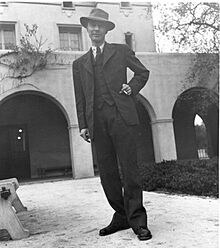
During World War II, Caltech helped with important research for the war effort. Some Caltech scientists, like J. Robert Oppenheimer, helped develop the atomic bomb. Caltech also worked with the U.S. Navy to create new military technologies. They developed rockets like the "Holy Moses" and the "Tiny Tim". These rockets were used in battles. By the end of the war, Caltech's rocket research was very important for the U.S. military.
After the War
From the 1950s to the 1980s, Caltech was home to Murray Gell-Mann and Richard Feynman. Their work was key to understanding tiny particles in physics. Feynman was also known as a great teacher and a fun, unusual person.
During Lee A. DuBridge's time as president (1946–1969), Caltech's teachers and campus grew a lot. New areas of research, like chemical biology and planetary science, became popular. A huge 200-inch telescope was built on Palomar Mountain in 1948. It was the world's most powerful optical telescope for over 40 years.
Caltech started accepting female undergraduate students in 1970. Since then, more and more women have joined the student body.
In January 2021, Caltech decided to remove the names of six historical figures from campus buildings. This was because of their past connections to a group called the Human Betterment Foundation, which supported ideas that are now seen as wrong. For example, Millikan Library was renamed Caltech Hall.
Caltech Campus
Caltech's main campus is 124 acres (50 hectares) in Pasadena, California. It's close to Old Town Pasadena, a popular area for students to visit.
In 1917, architect Bertram Goodhue designed the campus layout. He made sure the buildings fit the local weather and the school's goals. His designs were also inspired by the old Spanish mission architecture of Southern California.
The campus grew a lot in the 1960s, thanks to donations from former student Arnold O. Beckman. He and his wife, Mabel, greatly influenced Caltech's future.
New buildings on campus include the Cahill Center for Astronomy and Astrophysics and the Walter and Leonore Annenberg Center for Information Science and Technology, which opened in 2009. The Warren and Katherine Schlinger Laboratory for Chemistry and Chemical Engineering opened in 2010. Caltech also added a large solar array in 2010 to produce clean energy.
-
Aerial view of Caltech in Pasadena, California
How Caltech is Organized
Caltech is run by a group of 46 trustees. They choose a president to lead the school and other important officials. The current president is Thomas F. Rosenbaum, who started in 2014.
The school has six main academic divisions:
- Biology and Biological Engineering
- Chemistry and Chemical Engineering
- Engineering and Applied Science
- Geological and Planetary Sciences
- Humanities and Social Sciences
- Physics, Mathematics, and Astronomy
Caltech is very careful when choosing new teachers. They want the best people, so some positions might stay open for a while. Teachers at Caltech are expected to teach, do research, help students, and serve on committees.
The Jet Propulsion Laboratory (JPL) is a special research center owned by NASA. Caltech manages JPL through a contract with NASA. JPL does a lot of research and development, and has over 5,000 employees.
In December 2023, graduate students and researchers at Caltech formed a union. They voted in favor of unionizing in February 2024.
Academics at Caltech
Caltech is a small university with more graduate students than undergraduate students. It offers a four-year program focused on science and arts. Caltech uses the quarter system, with three terms each year.
Getting into Caltech
| Admissions statistics | |
|---|---|
|
2028 entering
classChange vs. 2023 |
|
| Admit rate | 2.6%
(
|
| Yield rate | 61.2%
(
|
| Test scores middle 50% | |
| SAT Total | 1530–1570 |
| ACT Composite | 35–36 |
| Year | Admit Rate | Yield Rate |
|---|---|---|
| 2024 | 2.6% | 61.2% |
| 2023 | 3.1% | 60.2% |
| 2022 | 2.7% | 50.0% |
| 2021 | 3.9% | 52.9% |
| 2020 | 6.7% | 42.0% |
| 2019 | 6.4% | 43.9% |
It's very hard to get into Caltech. For the class entering in 2024, only 2.7% of applicants were accepted. This makes Caltech one of the hardest colleges to get into in America. Caltech does not consider test scores like the SAT or ACT for admissions.
For the class entering in Fall 2023, Caltech received over 13,000 applications and accepted 412 students.
What Undergraduates Study
Caltech offers 28 main areas of study, called "options," and 17 smaller areas, called "minors." These are spread across all six academic divisions. Popular options include Chemical Engineering, Computer Science, Electrical Engineering, Mechanical Engineering, and Physics.
All undergraduate students must complete a core set of classes in their first two years. This includes math, physics, chemistry, biology, computer science, writing, and humanities. These classes give students a strong base in science and other important skills. First-year students take their classes on a Pass/Fail basis to help them adjust.
Students are encouraged to work together on homework. The honor system allows for take-home tests and flexible schedules. Caltech also has programs with other schools like the Pasadena Art Center College of Design.
Caltech graduates earn good salaries. A study in 2018 showed that Caltech graduates earn a median early career salary of $83,400.
Graduate Programs
Getting into Caltech for graduate studies is also very competitive. Teachers look at a student's academic background, research experience, and interests. Many programs no longer require GRE test scores.
Caltech's graduate programs focus on doctoral degrees in science, technology, engineering, and math. The most popular graduate options are Chemistry, Physics, Biology, Electrical Engineering, and Chemical Engineering.
New graduate students usually get a temporary advisor to help them find a permanent one. Some programs let students try out different research labs to find the best fit.
Caltech offers housing for new graduate students. About half of all graduate students live on campus.
Graduate students can use Caltech's research facilities. They can also work at places like NASA's Jet Propulsion Laboratory. Caltech also has a program with medical schools where students can earn both a medical degree and a PhD.
Almost all doctoral students receive full financial support through scholarships or research jobs. Graduate students also follow the same honor code as undergraduates.
Rankings
|
|
|
||||||||||||||||||||||||||||||||||||||||||||||||||||||||||||||
Caltech is often ranked among the top ten universities in the world. For 2022, U.S. News & World Report ranked Caltech as tied for 9th in the United States among national universities. Its graduate programs in chemistry and earth sciences were ranked first.
Research at Caltech
Caltech is known for its very high level of research, especially in science, technology, engineering, and math (STEM) fields. Caltech manages about $270 million in research spending each year. The biggest supporters of Caltech's research are government agencies like NASA and the National Science Foundation.
In 2005, Caltech had a lot of space dedicated to research. This included large areas for physical sciences, engineering, and biological sciences.
Besides managing JPL, Caltech also runs several observatories. These include the Palomar Observatory and the W. M. Keck Observatory. It also operates the Laser Interferometer Gravitational-Wave Observatory, which detected ripples in spacetime called gravitational waves for the first time in 2015. Caltech physicists Kip Thorne and Barry Barish, along with MIT physicist Rainer Weiss, won the 2017 Nobel Prize in Physics for this discovery.
Caltech also has the Kavli Nanoscience Institute and the Keck Institute for Space Studies. The Einstein Papers Project, which collects and publishes Albert Einstein's writings, is also located at Caltech.
Undergraduate students at Caltech are encouraged to do research. About 80% of students participate in the Summer Undergraduate Research Fellowships (SURF) program. This program helps students prepare for graduate school.
Caltech helps turn new scientific ideas into useful products. It has received many patents for inventions by its researchers.
Caltech Students
| Race and ethnicity | Total | ||
|---|---|---|---|
| Asian | 35% |
|
|
| White | 23% |
|
|
| Hispanic | 22% |
|
|
| Other | 9% |
|
|
| Foreign national | 8% |
|
|
| Black | 3% |
|
|
| Economic diversity | |||
| Low-income | 11% |
|
|
| Affluent | 89% |
|
|
For the 2024–2025 school year, Caltech had 987 undergraduate students and 1,443 graduate students. Women made up 45% of undergraduates and 36% of graduate students.
Most students graduate from Caltech. About 92% of students finish their degree within six years.
Student Life
House System
Caltech has a special housing system for undergraduates, similar to residential colleges. There are several "Houses" where students live. The four original South Houses are Blacker House, Dabney House, Fleming House, and Ricketts House. Later, three North Houses were built: Lloyd House, Page House, and Ruddock House. Avery House was added in the 1990s. The newest residence, Bechtel Residence, opened in 2018. All first- and second-year students live on campus.
In January 2021, Ruddock House was renamed Grant D. Venerable House. This was because of Albert B. Ruddock's past connection to the Human Betterment Foundation.
Sports and Athletics
Caltech has sports teams for baseball, basketball, soccer, swimming, tennis, track and field, volleyball, and water polo. Their mascot is the Beaver, which represents nature's engineer. Caltech's teams are part of the NCAA Division III and compete in the Southern California Intercollegiate Athletic Conference (SCIAC). Caltech helped start this conference in 1915.
The men's basketball team ended a long losing streak in 2007. They won their first Division III game since 1996. The women's basketball team also broke a long losing streak in 2007. The documentary film Quantum Hoops is about the men's basketball team's 2005–06 season.
In 2013, the Caltech baseball team ended a 228-game losing streak, winning for the first time in almost 10 years.
Arts and Music
The Caltech/Occidental College Orchestra is a large orchestra with students, teachers, and staff from both schools. They perform concerts several times a year. Caltech also has Jazz Bands, a Concert Band, and groups for chamber music. For singing, there's a Glee Club and Chamber Singers. The theater group, TACIT, puts on two to three plays each year. They also helped with the movie PHD Movie.
Student Traditions
Yearly Events
Every Halloween, students from Dabney House do the "Millikan pumpkin-drop experiment." They drop a pumpkin frozen in liquid nitrogen from the top of Millikan Library. People watch to see if it makes a spark when it shatters. This event is named after the famous Millikan oil-drop experiment.
On Ditch Day, senior students leave behind clever puzzles and traps at their dorm room doors. Younger students try to solve these "stacks" to get into the rooms. Teachers even cancel classes so everyone can join in the fun.
Another tradition is playing Wagner's "Ride of the Valkyries" very loudly at 7:00 AM every morning during finals week. It's not allowed at any other time.
Pranks
Caltech students are famous for their many pranks, also called "RFs."
Two well-known pranks include changing the Hollywood Sign to say "Caltech" and changing the scoreboard at the 1984 Rose Bowl Game to show "Caltech 38, MIT 9." The most famous prank happened during the 1961 Rose Bowl Game. Caltech students changed the flip-cards held by fans to spell out "Caltech" and other funny messages. This is known as the Great Rose Bowl Hoax.
In recent years, the school has even encouraged pranking. In 2011, Caltech students made a sculpture in New York look like the Weighted Companion Cube from the video game Portal.
Caltech pranks are written about in the Legends of Caltech books.
Rivalry with MIT
Caltech has a fun rivalry with the MIT. In 2005, Caltech students played pranks during MIT's visiting weekend. They covered part of the "Massachusetts Institute of Technology" sign to make it say "That Other Institute of Technology." MIT students changed it to "The Only Institute of Technology." Caltech students also gave out T-shirts that said "MIT... because not everyone can go to Caltech."
In 2006, MIT students pretended to be a moving company and stole Caltech's 130-year-old, 1.7-ton Fleming House cannon. They moved it over 3,000 miles to their campus. Caltech students traveled to MIT and got their cannon back.
In 2007, Caltech students handed out fake copies of MIT's campus newspaper. The fake articles had funny headlines like "MIT Invents the Interweb."
In 2009, Caltech students declared that MIT had been sold and was now "Caltech East." They hung signs and distributed fake newspapers to make it seem real.
In 2014, Caltech students gave out special mugs at MIT's visiting weekend. The mugs had the MIT logo, but when heated, they turned orange and said "Caltech The Hotter Institute of Technology."
Honor Code
Life at Caltech is guided by an honor code. It simply states: "No member of the Caltech community shall take unfair advantage of any other member of the Caltech community." This code is enforced by student groups.
The honor code creates an atmosphere of trust. It allows students to have privileges like taking most exams home. This means students can take tests on their own time and in a comfortable place.
Famous People from Caltech
As of October 2024, 48 Nobel laureates have been connected to Caltech. This includes 26 former students and 17 teachers. The Turing Award, often called the "Nobel Prize of Computer Science," has been given to six former students. One alumnus also won the Fields Medal in math.
Alumni
There are over 22,930 living alumni from Caltech around the world. Many have become famous scientists and engineers.
Some alumni studied tiny particles. Carl D. Anderson (graduated 1927, 1930) proved the existence of positrons. Edwin McMillan (graduated 1928, 1929) created the first transuranium element. Douglas D. Osheroff (graduated 1967) studied the special nature of helium-3. Donald Knuth (graduated 1963), known as the "father" of analysis of algorithms, wrote important computer programming books.
Other alumni looked to the stars. Astronaut C. Gordon Fullerton (graduated 1957, 1958) piloted a Space Shuttle mission. Astronaut Harrison Schmitt (graduated 1957) was the only geologist to walk on the Moon. Astronomer Eugene Merle Shoemaker (graduated 1947, 1948) co-discovered a comet that crashed into Jupiter.
Caltech alumni have also started many successful companies. These include Hotmail, Compaq, MathWorks (which created Matlab), and Intel. Arnold Beckman (graduated 1928) invented the pH meter. His success helped fund William Shockley (graduated 1932), who co-invented semiconductor transistors. Shockley's work led to the creation of "Silicon Valley" in California.
Caltech alumni have also held important government jobs. These include the Administrator of NASA, the Undersecretary of Energy for Science, and the director of DARPA.
- Notable Caltech alumni include:
-
Nobel laureate William Shockley, BS 1932, co-inventor of the solid state transistor, father of Silicon Valley
-
Qian Xuesen, PhD 1939, co-founder of JPL, "Father" of Chinese rocketry
-
Turing Award laureate John McCarthy, BS 1948, inventor of the Lisp programming language
-
Benoit Mandelbrot, MS 1948, Engineering 1949, father of fractal geometry, namesake of the Mandelbrot set
-
Gordon Moore, PhD 1954, co-founder of Intel, coined the observation Moore's Law
-
Astronaut C. Gordon Fullerton, BS 1957, MS 1958
-
Astronaut and United States Senator Harrison Schmitt, BS 1957, the only geologist to have walked on the Moon
-
Nobel laureate Kip Thorne, BS 1962, known for his prolific contributions in gravitation physics and astrophysics and co-founding of LIGO
-
Turing Award laureate Donald Knuth, PhD 1963, "father" of the analysis of algorithms, creator of TeX typesetting system
-
Mark S. Wrighton, PhD 1972, Chancellor of Washington University in St. Louis and President of George Washington University
-
France A. Córdova, PhD 1978, Astrophysicist and 14th Director of the National Science Foundation
-
Stephen Wolfram, PhD 1979, creator of Mathematica and Wolfram Alpha; one of the first MacArthur Fellows in 1981
-
Carolyn Porco, PhD 1983, planetary scientist who led the imaging team on the Cassini mission in orbit around Saturn
-
Andrea M. Ghez, PHD 1992 Nobel Prize in Physics recipient and professor at University of California, Los Angeles
-
Bob Behnken, MS, 1993; PhD, 1997, Former NASA Astronaut and Chief of theAstronaut Office
-
Adam D'Angelo, BS 2006, Founder of Quora
Faculty and Staff
Richard Feynman was a very famous physicist at Caltech. He wrote books that explained physics to students and the public. His work in quantum electrodynamics won him a Nobel Prize. Murray Gell-Mann, another Nobel-winning physicist, helped discover tiny particles called quarks.
Long-time Caltech President Robert Andrews Millikan was the first to figure out the charge of an electron using his famous oil-drop experiment. H. David Politzer, a 2004 Nobel Prize winner in Physics, is a current professor. So are astrophysicist and author Kip Thorne and mathematician Barry Simon.
Linus Pauling was a pioneer in understanding how chemicals bond together. Seismologist Charles Richter, also a former student, created the Richter magnitude scale to measure earthquakes. Clair Patterson was the first to accurately find the age of the Earth.
In engineering, Theodore von Kármán made many important discoveries in how air flows around objects. He helped create the Jet Propulsion Laboratory. His students included Frank Malina, who helped develop early U.S. rockets, and Qian Xuesen, who became known as the "Father of Chinese Rocketry." More recently, Michael Brown, a professor of planetary astronomy, discovered many objects beyond Neptune, including the dwarf planet Eris.
Many Caltech teachers are members of important national academies, like the National Academy of Sciences. This shows how highly respected they are in their fields.
Presidents
The following people have led Caltech since 1921:
| No. | Image | Name | Term start | Term end | Field | Refs. |
|---|---|---|---|---|---|---|
| 1 |  |
Robert A. Millikan | 1921 | August 31, 1945 | Physics | |
| 2 |  |
Lee A. DuBridge | September 1, 1946 | January 15, 1969 | Physics | |
| acting |  |
Robert Bacher | January 16, 1969 | February 16, 1969 | Physics | |
| 3 |  |
Harold Brown | February 17, 1969 | January 20, 1977 | Physics | |
| acting |  |
Robert F. Christy | January 21, 1977 | June 30, 1978 | Astrophysics | |
| 4 |  |
Marvin L. Goldberger | July 1, 1978 | August 31, 1987 | Physics | |
| 5 |  |
Thomas E. Everhart | September 1, 1987 | October 14, 1997 | Physics | |
| 6 |  |
David Baltimore | October 15, 1997 | August 31, 2006 | Molecular biology | |
| 7 | Jean-Lou Chameau | September 1, 2006 | June 30, 2013 | Civil engineering | ||
| Interim | Edward M. Stolper | July 1, 2013 | June 30, 2014 | Geology | ||
| 8 |  |
Thomas F. Rosenbaum | July 1, 2014 | Present | Physics |
Caltech Startups
Caltech actively helps turn new technologies developed at the school into real companies. Through its Office of Technology Transfer, many scientific breakthroughs have led to new businesses. These companies work in areas like photovoltaics (solar energy), radio-frequency identification (RFID), semiconductors, and more. Companies like Quora, Impinj, and Xencor have come out of Caltech.
See also
 In Spanish: Instituto Tecnológico de California para niños
In Spanish: Instituto Tecnológico de California para niños
- Engineering education


